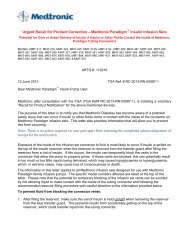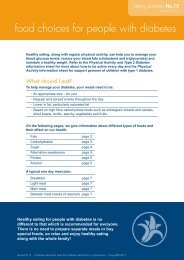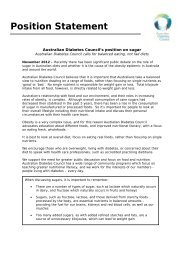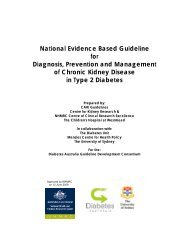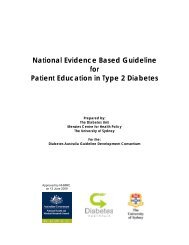Tamil - Australian Diabetes Council
Tamil - Australian Diabetes Council
Tamil - Australian Diabetes Council
- No tags were found...
Create successful ePaper yourself
Turn your PDF publications into a flip-book with our unique Google optimized e-Paper software.
13<br />
Blood Glucose (Sugar) Monitoring<br />
Monitoring blood glucose levels is important to help you manage<br />
your diabetes. Self blood glucose testing is a way of measuring how<br />
much glucose is in your blood.<br />
A drop of blood is obtained by pricking the finger with a needle<br />
called a lancet. The blood is applied to a test strip, and inserted into<br />
a blood glucose machine (meter). The blood glucose(sugar) level is<br />
then displayed.<br />
There are many types of meters available. Ask your doctor or diabetes educator which meter<br />
suits you. You will also need to be shown how to use your meter.<br />
Why you should monitor your blood glucose (sugar) level<br />
Blood glucose levels respond to food, particularly carbohydrates. Other factors like physical<br />
activity, diabetes medication, changes in your daily routine, stress and illness will also cause<br />
blood glucose levels to go up or down.<br />
Visits to a doctor or heath professional may be weeks or months apart. It is important to<br />
know and understand the readings/blood glucose levels and make some self-management<br />
decisions in between doctors visits.<br />
The benefits of using a meter include:<br />
• Seeing if your blood glucose level is too high or too low<br />
• Gives you a picture of your day to day diabetes management<br />
• Shows you whether your blood glucose levels are within your<br />
recommended target range<br />
• Shows you the effects of food, physical activity and medication on<br />
your blood glucose (sugar) level<br />
• Gives you confidence to self-manage your diabetes.<br />
This gives you and your diabetes health care team the information needed to help you<br />
manage your diabetes.<br />
When you should monitor your blood glucose (sugar) level<br />
Blood glucose monitoring is usually done before meals or two hours after the start of a main<br />
meal. Ask your doctor or diabetes educator for advice on when and how often you need to<br />
check your blood glucose level.<br />
It is safe practice to check your blood glucose level before driving and on long journeys,<br />
especially for those people who are at risk of hypoglycaemia.<br />
Monitor your blood glucose level more often:<br />
• If you are sick<br />
• When adjusting tablets or insulin doses<br />
• When blood glucose levels are high -for example over 15 mmol/L<br />
• After exercise<br />
• After alcohol intake.<br />
60






